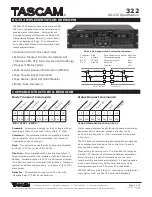
The PrimeSight UNITY 9000 Video Processor User Manual
7 - Maintenance and Storage
46
7.2 ROUTINE PERIODIC INSPECTION
Although the PrimeSight UNITY 9000 Video Processor contains no user-serviceable parts (except
for fuse replacement), there are periodic inspection procedures that users can perform in addition
to those performed before and/or after procedures to assist in detecting problems that could affect
the unit’s operation. Steps in such an inspection procedure include:
• Verify that the Video Processor’s power plug and signal connections are securely attached.
• Verify that all switches and lights on the Video Processor are working properly.
• Verify that all cables are in good condition and have not sustained any damage beyond
normal wear and tear.
• Verify that all equipment is in good working condition immediately after routine cleaning/
disinfection, or after the Video Processor is transported or moved between locations.
7.3 SURFACE CLEANING AND DISINFECTION
Failure to properly clean the surface of the Video Processor may impair
effective surface disinfection.
Do not allow liquids or excessive moisture to get on or into the Video
Processor. This could cause equipment damage.
Do not use cleaning/disinfecting agents that are not permitted for use
with plastics, such as ammonia, acetone, or salty acids (e.g., HCl). Such
agents could weaken and/or otherwise damage the surfaces of the Video
Processor.
The cleaning/disinfecting procedure should be performed while the
Videoscope cable’s plug is connected to the Video Processor to prevent
excess fluid from entering the receptacle.
Do not use incompatible cleaning/disinfecting agents on the Video
Processor’s LCD monitor (alcohols, for example). Doing so could damage
the display screen.
7.3.1 Acceptable Cleaning and Disinfection Materials
Cleaning
• A compatible electronics-surface detergent
• 70% isopropyl alcohol
• Soft material (gauze 4 x 4)
Disinfection
• A compatible electronics surface disinfectant
• 70% isopropyl alcohol
• Soft material (gauze 4 x 4)
















































